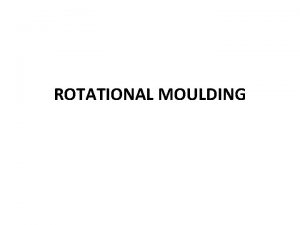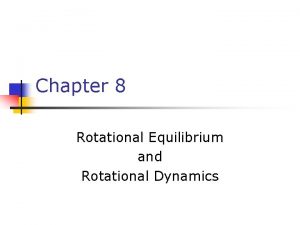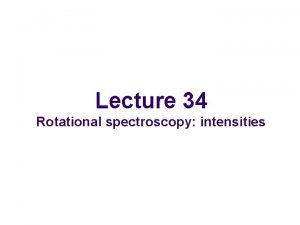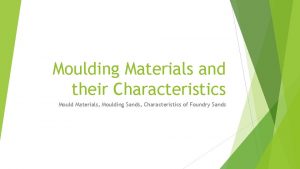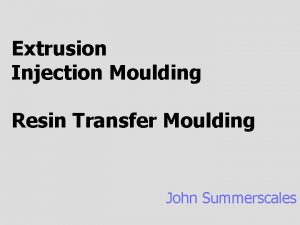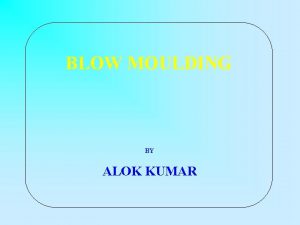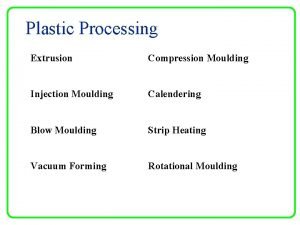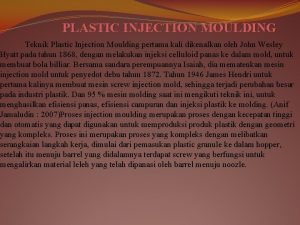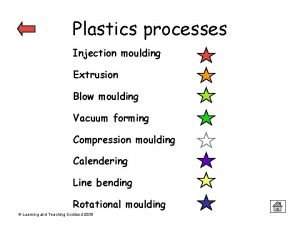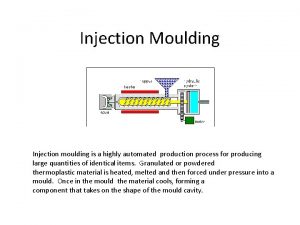PROPERTIES AND SELECTION OF MATERIALS ROTATIONAL MOULDING Presented











- Slides: 11

PROPERTIES AND SELECTION OF MATERIALS “ROTATIONAL MOULDING” Presented by: Presented to: GIRIJESH SHUKLA 2008 AMD 3102 DEPTT. OF APPLIED MECHANICS IIT DELHI PROF. M. P. GURURAJAN DEPTT. OF APPLIED MECHANICS IIT DELHI

ROTATIONAL MOULDING. Used for hollow plastics. . Plastic powder is used. . create consistency in wall thickness and density. It produces strong durable product.

PROCESS

CHARGING THE MOULD. filling of mould with determined quantity of powder metarial. . filling of material More than 80% of all the material used is from the POLYTYLINE family. Some common materials are: Polyethylene Polypropylene Polyvinyl Chloride Nylon

HEATING AND ROTATIONAL PROCESS • • Both process happens simultaneously Time of heating is very critical Mould is rotated on two perpendicular axies. No pressure is being applied.

Cooling of mould and De molding . Bi-axial rotation is continued. . Cooling is being done by air or water. . Generally it is being done by fan. . This process is quite lengthy and very time taking.

Advantages • A hollow part is made in a single piece with no weld lines or joints • Product essentially stress-free • The molds are relatively inexpensive • There is no material wastage in this molding process. • It is of low cost with respect to the other molding process. • Low residual stress • It is also possible to make multilayer products • Inserts are relatively easy to mold in

Disadvantages • The manufacturing times are long. • The choice of molding materials is limited. • the material cost are relatively very high because most the time we will have to add some additives to make the powder of plastics. these both the things are very expensive • There is chance of air trapping in the mould. • Some geometrical features (such as ribs) are difficult to mold

Limitation. temperature. oxidation. Thickness

Application • Tanks- fuel tanks, shipping tanks, oil tanks • Automotive-door armrest, instruments panel • Containers-planters , airline container • Toys and Leisure-balls , ride on toys, hobby horses • Marine Industry-dock floats, pool liners, docking fenders

THANK YOU
 Rotational molding advantages and disadvantages
Rotational molding advantages and disadvantages Strengh
Strengh Chapter 11 rotational equilibrium
Chapter 11 rotational equilibrium Rotational equilibrium and rotational dynamics
Rotational equilibrium and rotational dynamics Gross selection rule for rotational spectroscopy
Gross selection rule for rotational spectroscopy Two way selection and multiway selection in c
Two way selection and multiway selection in c Multiway selection in c
Multiway selection in c Mass selection and pure line selection
Mass selection and pure line selection Cant stop the feeling trolls go noodle
Cant stop the feeling trolls go noodle Household materials useful harmful
Household materials useful harmful Natural materials and man made materials
Natural materials and man made materials Adapting and adopting materials
Adapting and adopting materials
